Hyundai Matrix 2007 Service Manual
Manufacturer: HYUNDAI, Model Year: 2007, Model line: Matrix, Model: Hyundai Matrix 2007Pages: 490, PDF Size: 12.81 MB
Page 41 of 490
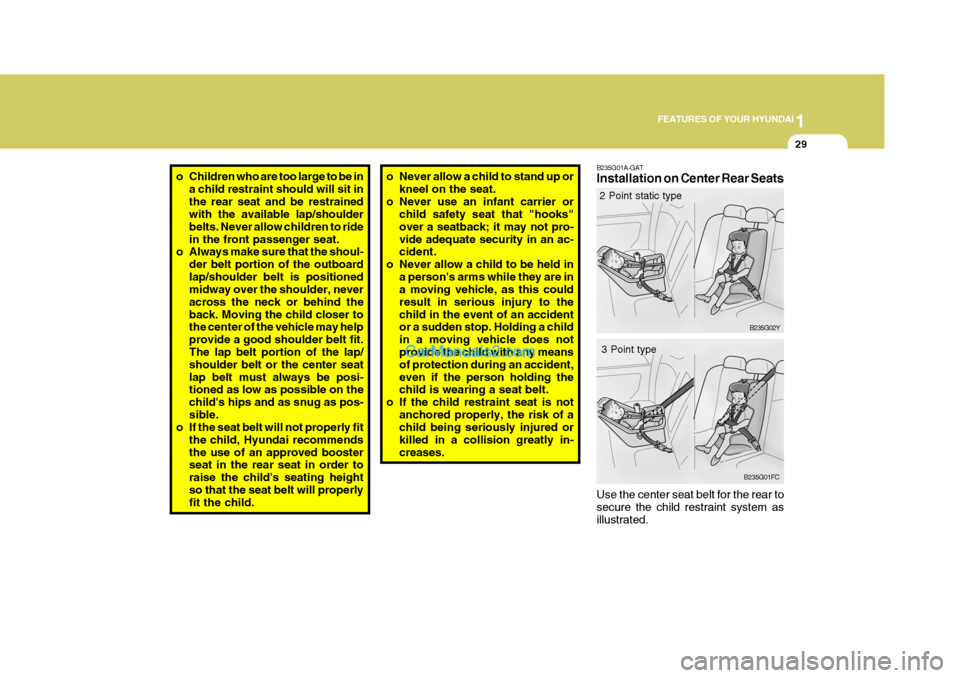
1
FEATURES OF YOUR HYUNDAI
29
o Children who are too large to be in
a child restraint should will sit in the rear seat and be restrained with the available lap/shoulder belts. Never allow children to ridein the front passenger seat.
o Always make sure that the shoul-
der belt portion of the outboardlap/shoulder belt is positioned midway over the shoulder, never across the neck or behind theback. Moving the child closer to the center of the vehicle may help provide a good shoulder belt fit. The lap belt portion of the lap/ shoulder belt or the center seatlap belt must always be posi- tioned as low as possible on the child's hips and as snug as pos-sible.
o If the seat belt will not properly fit
the child, Hyundai recommendsthe use of an approved booster seat in the rear seat in order to raise the child's seating heightso that the seat belt will properly fit the child.o Never allow a child to stand up orkneel on the seat.
o Never use an infant carrier or child safety seat that "hooks" over a seatback; it may not pro-vide adequate security in an ac- cident.
o Never allow a child to be held in
a person's arms while they are ina moving vehicle, as this could result in serious injury to thechild in the event of an accident or a sudden stop. Holding a child in a moving vehicle does not provide the child with any means of protection during an accident,even if the person holding the child is wearing a seat belt.
o If the child restraint seat is not
anchored properly, the risk of achild being seriously injured or killed in a collision greatly in-creases. B235G01A-GAT Installation on Center Rear Seats
B235G02Y
B235G01FC
2 Point static type
3 Point type
Use the center seat belt for the rear to secure the child restraint system as illustrated.
Page 42 of 490
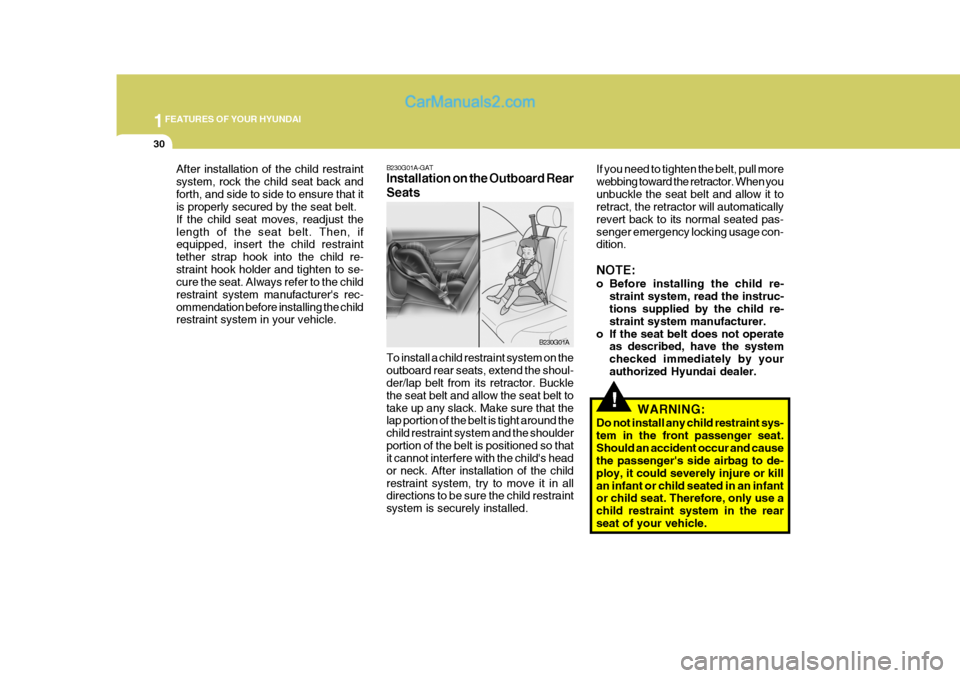
1FEATURES OF YOUR HYUNDAI
30
!
If you need to tighten the belt, pull more webbing toward the retractor. When youunbuckle the seat belt and allow it to retract, the retractor will automatically revert back to its normal seated pas-senger emergency locking usage con- dition. NOTE:
o Before installing the child re-
straint system, read the instruc- tions supplied by the child re- straint system manufacturer.
o If the seat belt does not operate as described, have the systemchecked immediately by yourauthorized Hyundai dealer.
WARNING:
Do not install any child restraint sys-tem in the front passenger seat.Should an accident occur and cause the passenger's side airbag to de- ploy, it could severely injure or killan infant or child seated in an infant or child seat. Therefore, only use a child restraint system in the rearseat of your vehicle.
B230G01A-GAT Installation on the Outboard Rear Seats To install a child restraint system on the outboard rear seats, extend the shoul- der/lap belt from its retractor. Buckle the seat belt and allow the seat belt totake up any slack. Make sure that the lap portion of the belt is tight around the child restraint system and the shoulderportion of the belt is positioned so that it cannot interfere with the child's head or neck. After installation of the childrestraint system, try to move it in all directions to be sure the child restraint system is securely installed.
B230G01A
After installation of the child restraintsystem, rock the child seat back andforth, and side to side to ensure that it is properly secured by the seat belt. If the child seat moves, readjust thelength of the seat belt. Then, if equipped, insert the child restraint tether strap hook into the child re-straint hook holder and tighten to se- cure the seat. Always refer to the child restraint system manufacturer's rec-ommendation before installing the child restraint system in your vehicle.
Page 43 of 490
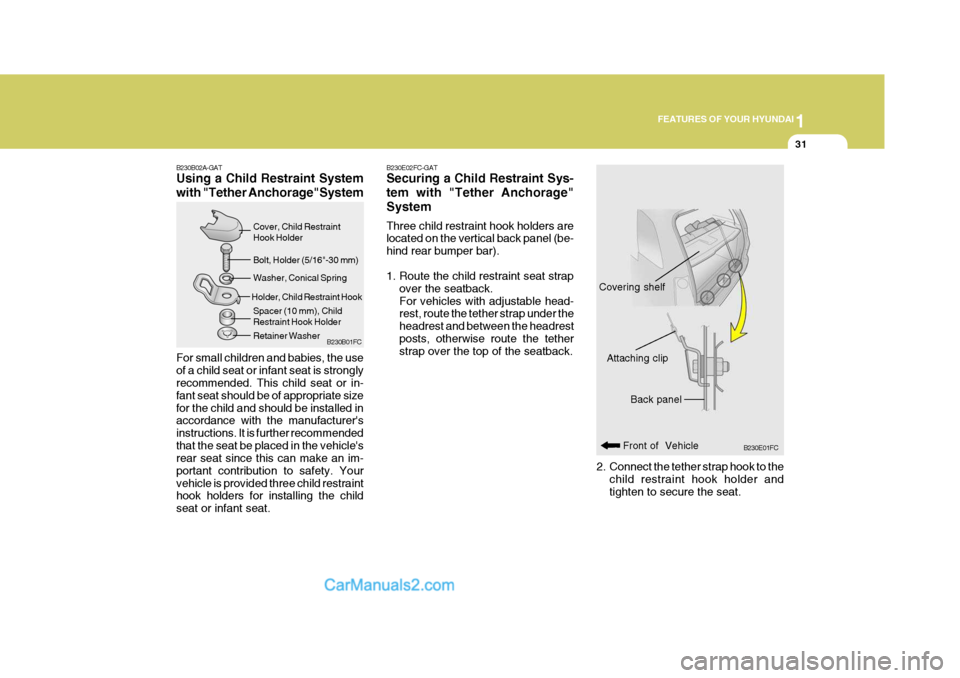
1
FEATURES OF YOUR HYUNDAI
31
B230B01FC
B230B02A-GAT Using a Child Restraint System with "Tether Anchorage"System For small children and babies, the use of a child seat or infant seat is strongly recommended. This child seat or in- fant seat should be of appropriate sizefor the child and should be installed in accordance with the manufacturer's instructions. It is further recommendedthat the seat be placed in the vehicle's rear seat since this can make an im- portant contribution to safety. Yourvehicle is provided three child restraint hook holders for installing the child seat or infant seat. B230E02FC-GAT Securing a Child Restraint Sys- tem with "Tether Anchorage"System Three child restraint hook holders are located on the vertical back panel (be- hind rear bumper bar).
1. Route the child restraint seat strap
over the seatback. For vehicles with adjustable head- rest, route the tether strap under the headrest and between the headrestposts, otherwise route the tether strap over the top of the seatback.
Cover, Child Restraint Hook Holder Bolt, Holder (5/16"-30 mm) Washer, Conical Spring
Holder, Child Restraint Hook Spacer (10 mm), Child Restraint Hook Holder Retainer Washer
B230E01FC
Front of Vehicle
Back panel
Covering shelf
Attaching clip
2. Connect the tether strap hook to the child restraint hook holder and tighten to secure the seat.
Page 44 of 490
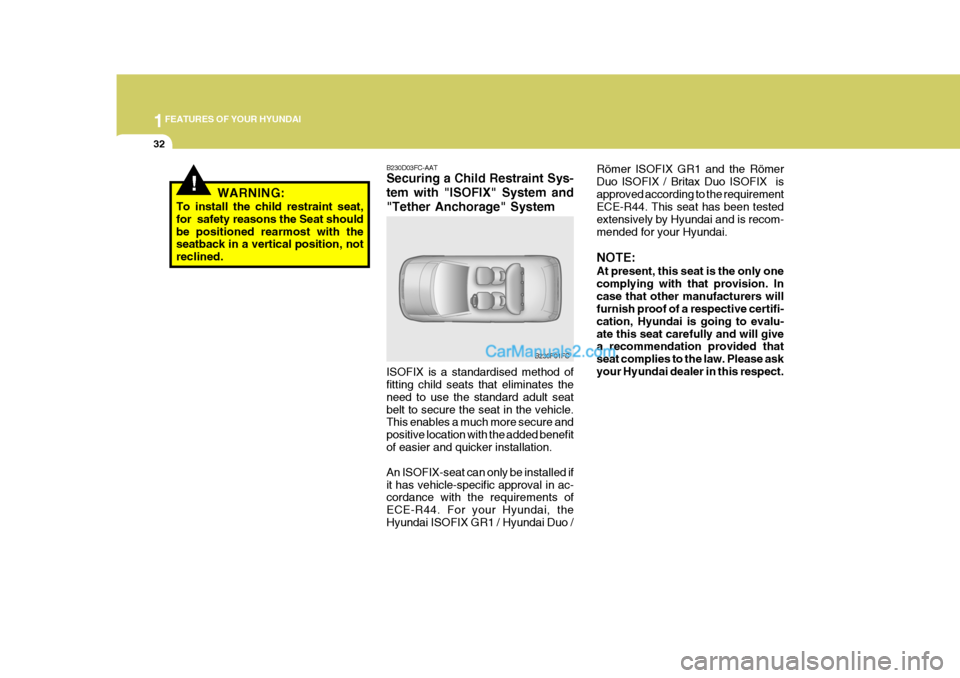
1FEATURES OF YOUR HYUNDAI
32
Römer ISOFIX GR1 and the Römer Duo ISOFIX / Britax Duo ISOFIX isapproved according to the requirement ECE-R44. This seat has been tested extensively by Hyundai and is recom-mended for your Hyundai. NOTE: At present, this seat is the only one complying with that provision. Incase that other manufacturers will furnish proof of a respective certifi- cation, Hyundai is going to evalu-ate this seat carefully and will give a recommendation provided that seat complies to the law. Please askyour Hyundai dealer in this respect.
!
B230D03FC-AAT Securing a Child Restraint Sys- tem with "ISOFIX" System and"Tether Anchorage" System ISOFIX is a standardised method of fitting child seats that eliminates the need to use the standard adult seatbelt to secure the seat in the vehicle. This enables a much more secure and positive location with the added benefitof easier and quicker installation. An ISOFIX-seat can only be installed if it has vehicle-specific approval in ac- cordance with the requirements of ECE-R44. For your Hyundai, theHyundai ISOFIX GR1 / Hyundai Duo / B230F01FC
WARNING:
To install the child restraint seat,for safety reasons the Seat shouldbe positioned rearmost with the seatback in a vertical position, not reclined.
Page 45 of 490
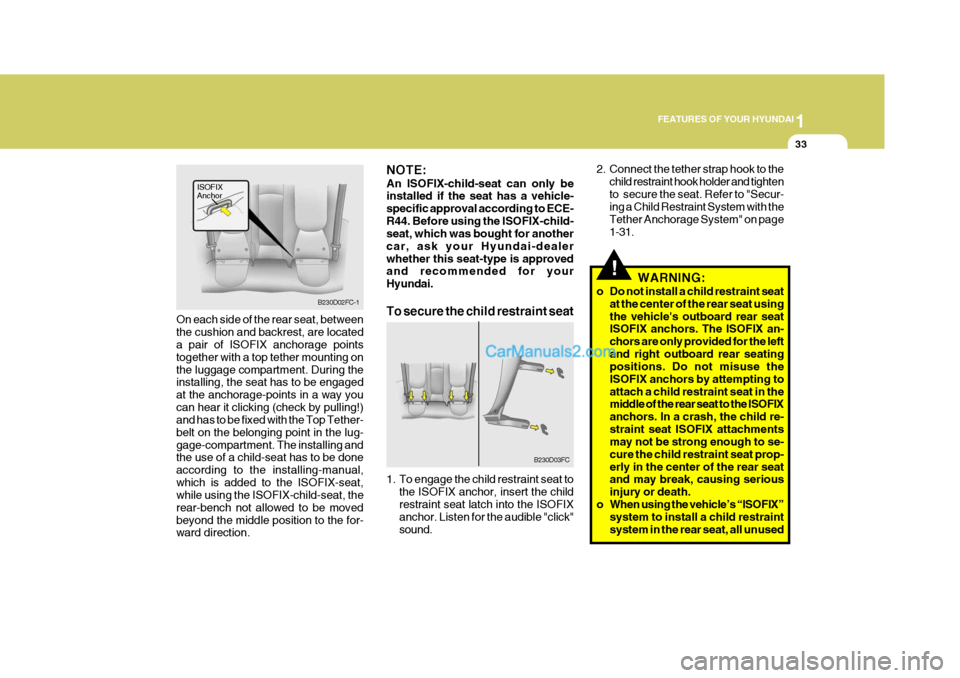
1
FEATURES OF YOUR HYUNDAI
33
2. Connect the tether strap hook to the
child restraint hook holder and tighten to secure the seat. Refer to "Secur- ing a Child Restraint System with the Tether Anchorage System" on page1-31.
B230D02FC-1
B230D03FC
On each side of the rear seat, betweenthe cushion and backrest, are located a pair of ISOFIX anchorage points together with a top tether mounting onthe luggage compartment. During the installing, the seat has to be engaged at the anchorage-points in a way youcan hear it clicking (check by pulling!) and has to be fixed with the Top Tether- belt on the belonging point in the lug-gage-compartment. The installing and the use of a child-seat has to be done according to the installing-manual,which is added to the ISOFIX-seat, while using the ISOFIX-child-seat, the rear-bench not allowed to be movedbeyond the middle position to the for- ward direction. ISOFIX Anchor
!WARNING:
o Do not install a child restraint seat at the center of the rear seat using the vehicle's outboard rear seat ISOFIX anchors. The ISOFIX an- chors are only provided for the leftand right outboard rear seating positions. Do not misuse the ISOFIX anchors by attempting toattach a child restraint seat in the middle of the rear seat to the ISOFIX anchors. In a crash, the child re-straint seat ISOFIX attachments may not be strong enough to se- cure the child restraint seat prop-erly in the center of the rear seat and may break, causing serious injury or death.
o When using the vehicle’s “ISOFIX” system to install a child restraintsystem in the rear seat, all unused
NOTE: An ISOFIX-child-seat can only be installed if the seat has a vehicle- specific approval according to ECE-R44. Before using the ISOFIX-child- seat, which was bought for another car, ask your Hyundai-dealerwhether this seat-type is approved and recommended for your Hyundai. To secure the child restraint seat
1. To engage the child restraint seat to
the ISOFIX anchor, insert the child restraint seat latch into the ISOFIX anchor. Listen for the audible "click"sound.
Page 46 of 490
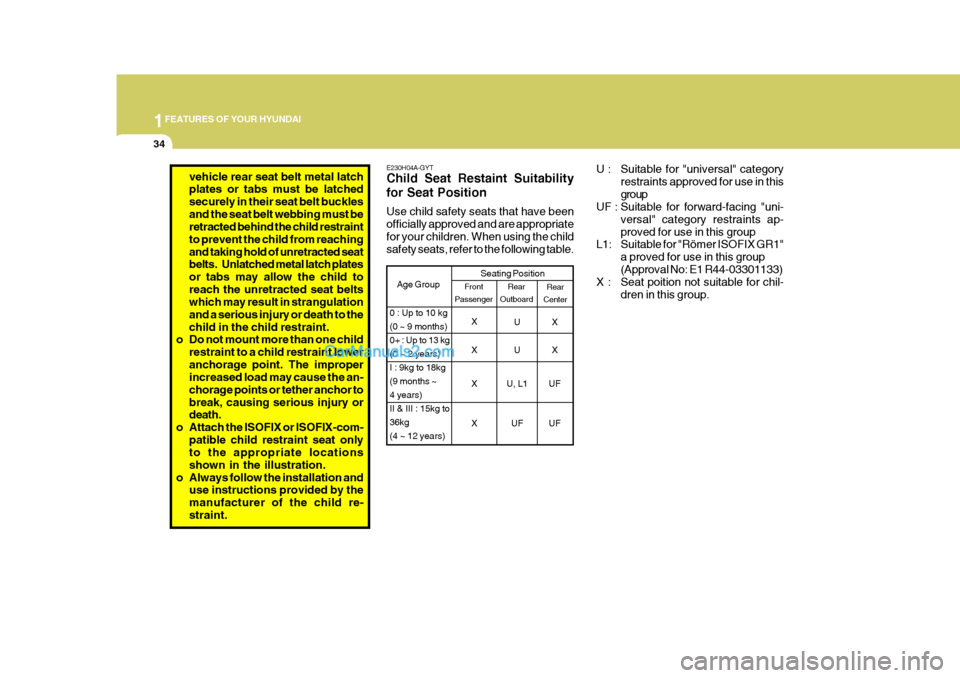
1FEATURES OF YOUR HYUNDAI
34
U : Suitable for "universal" categoryrestraints approved for use in this group
UF : Suitable for forward-facing "uni-
versal" category restraints ap-proved for use in this group
L1: Suitable for "Römer ISOFIX GR1"
a proved for use in this group(Approval No: E1 R44-03301133)
X : Seat poition not suitable for chil-
dren in this group.
Rear
Center
Age Group Seating Position
UX
XUX
X U, L1 UF XU FUF
Rear
Outboard
Front
Passenger
0 : Up to 10 kg (0 ~ 9 months)0+ : Up to 13 kg(0 ~ 2 years)I : 9kg to 18kg(9 months ~4 years)II & III : 15kg to36kg(4 ~ 12 years) X
E230H04A-GYT Child Seat Restaint Suitability for Seat Position Use child safety seats that have been officially approved and are appropriatefor your children. When using the child safety seats, refer to the following table.
vehicle rear seat belt metal latch plates or tabs must be latched securely in their seat belt bucklesand the seat belt webbing must be retracted behind the child restraint to prevent the child from reachingand taking hold of unretracted seat
belts. Unlatched metal latch plates or tabs may allow the child toreach the unretracted seat belts which may result in strangulation and a serious injury or death to thechild in the child restraint.
o Do not mount more than one child
restraint to a child restraint loweranchorage point. The improper increased load may cause the an- chorage points or tether anchor tobreak, causing serious injury or death.
o Attach the ISOFIX or ISOFIX-com- patible child restraint seat onlyto the appropriate locations shown in the illustration.
o Always follow the installation and use instructions provided by themanufacturer of the child re-straint.
Page 47 of 490
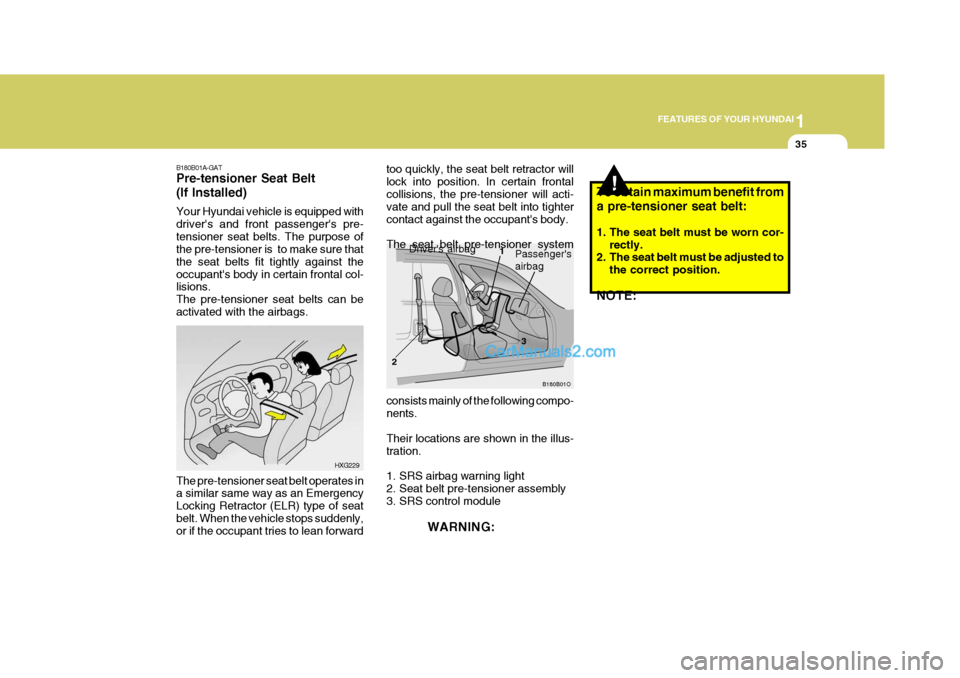
1
FEATURES OF YOUR HYUNDAI
35
too quickly, the seat belt retractor will lock into position. In certain frontalcollisions, the pre-tensioner will acti- vate and pull the seat belt into tighter contact against the occupant's body. The seat belt pre-tensioner system
HXG229
B180B01A-GAT Pre-tensioner Seat Belt (If Installed) Your Hyundai vehicle is equipped with driver's and front passenger's pre-tensioner seat belts. The purpose of the pre-tensioner is to make sure that the seat belts fit tightly against theoccupant's body in certain frontal col- lisions. The pre-tensioner seat belts can beactivated with the airbags. The pre-tensioner seat belt operates in a similar same way as an Emergency Locking Retractor (ELR) type of seatbelt. When the vehicle stops suddenly, or if the occupant tries to lean forward
B180B01O
Driver's airbag1
2 3Passenger's airbag
consists mainly of the following compo- nents. Their locations are shown in the illus- tration.
1. SRS airbag warning light
2. Seat belt pre-tensioner assembly
3. SRS control module WARNING:
!To obtain maximum benefit from a pre-tensioner seat belt:
1. The seat belt must be worn cor-rectly.
2. The seat belt must be adjusted to
the correct position.
NOTE:
Page 48 of 490
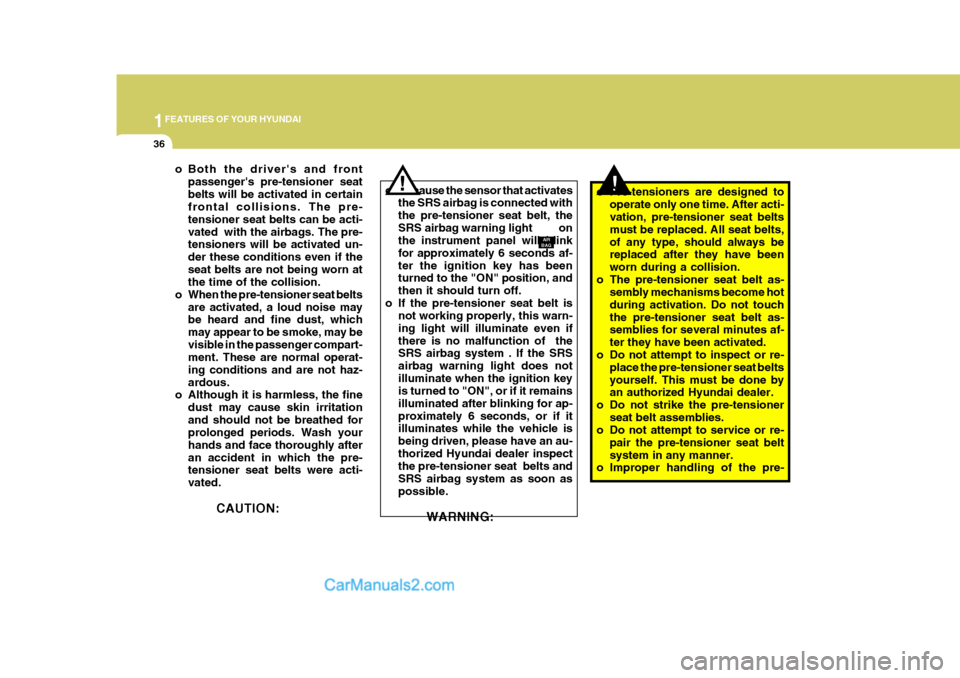
1FEATURES OF YOUR HYUNDAI
36
!o Pre-tensioners are designed to
operate only one time. After acti- vation, pre-tensioner seat belts must be replaced. All seat belts,of any type, should always be replaced after they have been worn during a collision.
o The pre-tensioner seat belt as- sembly mechanisms become hotduring activation. Do not touchthe pre-tensioner seat belt as- semblies for several minutes af- ter they have been activated.
o Do not attempt to inspect or re-
place the pre-tensioner seat beltsyourself. This must be done by an authorized Hyundai dealer.
o Do not strike the pre-tensioner seat belt assemblies.
o Do not attempt to service or re-
pair the pre-tensioner seat belt system in any manner.
o Improper handling of the pre-
o Because the sensor that activates
the SRS airbag is connected withthe pre-tensioner seat belt, theSRS airbag warning light on the instrument panel will blink for approximately 6 seconds af-ter the ignition key has been turned to the "ON" position, and then it should turn off.
o If the pre-tensioner seat belt is not working properly, this warn-ing light will illuminate even ifthere is no malfunction of the SRS airbag system . If the SRS airbag warning light does notilluminate when the ignition key is turned to "ON", or if it remains illuminated after blinking for ap-proximately 6 seconds, or if it illuminates while the vehicle is being driven, please have an au-thorized Hyundai dealer inspect the pre-tensioner seat belts and SRS airbag system as soon aspossible.
WARNING:!
AIR
BAG
o Both the driver's and front
passenger's pre-tensioner seat belts will be activated in certain frontal collisions. The pre- tensioner seat belts can be acti-vated with the airbags. The pre- tensioners will be activated un- der these conditions even if theseat belts are not being worn at the time of the collision.
o When the pre-tensioner seat belts are activated, a loud noise maybe heard and fine dust, which may appear to be smoke, may bevisible in the passenger compart- ment. These are normal operat- ing conditions and are not haz-ardous.
o Although it is harmless, the fine
dust may cause skin irritationand should not be breathed for prolonged periods. Wash your hands and face thoroughly afteran accident in which the pre- tensioner seat belts were acti- vated.
CAUTION:
Page 49 of 490
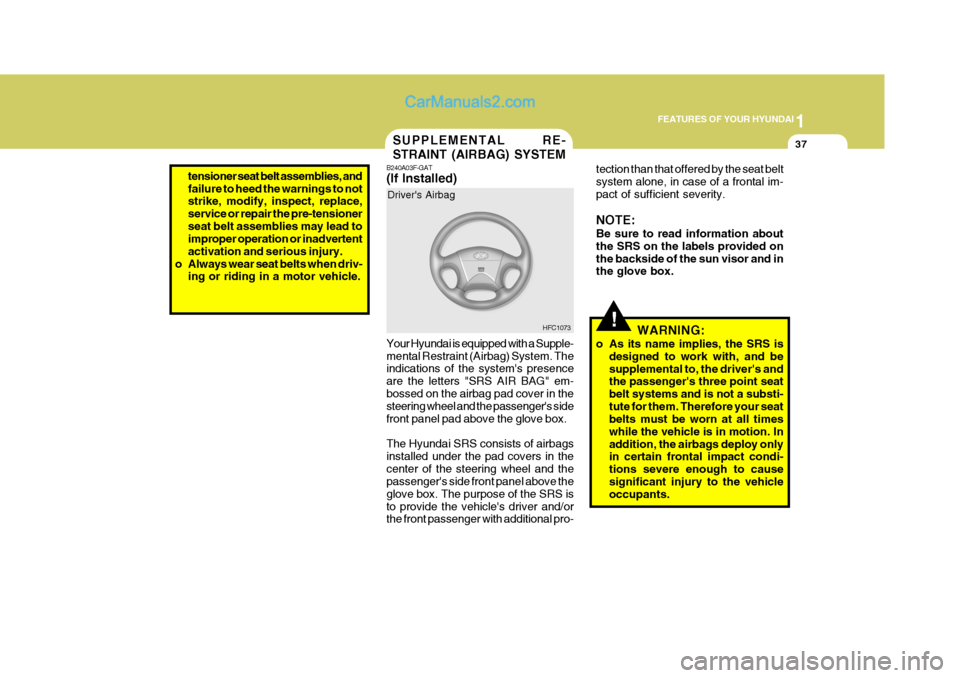
1
FEATURES OF YOUR HYUNDAI
37
tensioner seat belt assemblies, and failure to heed the warnings to not strike, modify, inspect, replace, service or repair the pre-tensionerseat belt assemblies may lead to improper operation or inadvertent activation and serious injury.
o Always wear seat belts when driv- ing or riding in a motor vehicle. B240A03F-GAT (If Installed) Your Hyundai is equipped with a Supple- mental Restraint (Airbag) System. The indications of the system's presence are the letters "SRS AIR BAG" em-bossed on the airbag pad cover in the steering wheel and the passenger's side front panel pad above the glove box. The Hyundai SRS consists of airbags installed under the pad covers in thecenter of the steering wheel and the passenger's side front panel above the glove box. The purpose of the SRS isto provide the vehicle's driver and/or the front passenger with additional pro-HFC1073
Driver's Airbag
SUPPLEMENTAL RE- STRAINT (AIRBAG) SYSTEM
!
tection than that offered by the seat belt system alone, in case of a frontal im-pact of sufficient severity. NOTE: Be sure to read information about the SRS on the labels provided onthe backside of the sun visor and in the glove box.
WARNING:
o As its name implies, the SRS is designed to work with, and be supplemental to, the driver's and the passenger's three point seat belt systems and is not a substi-tute for them. Therefore your seat belts must be worn at all times while the vehicle is in motion. Inaddition, the airbags deploy only in certain frontal impact condi- tions severe enough to causesignificant injury to the vehicle occupants.
Page 50 of 490
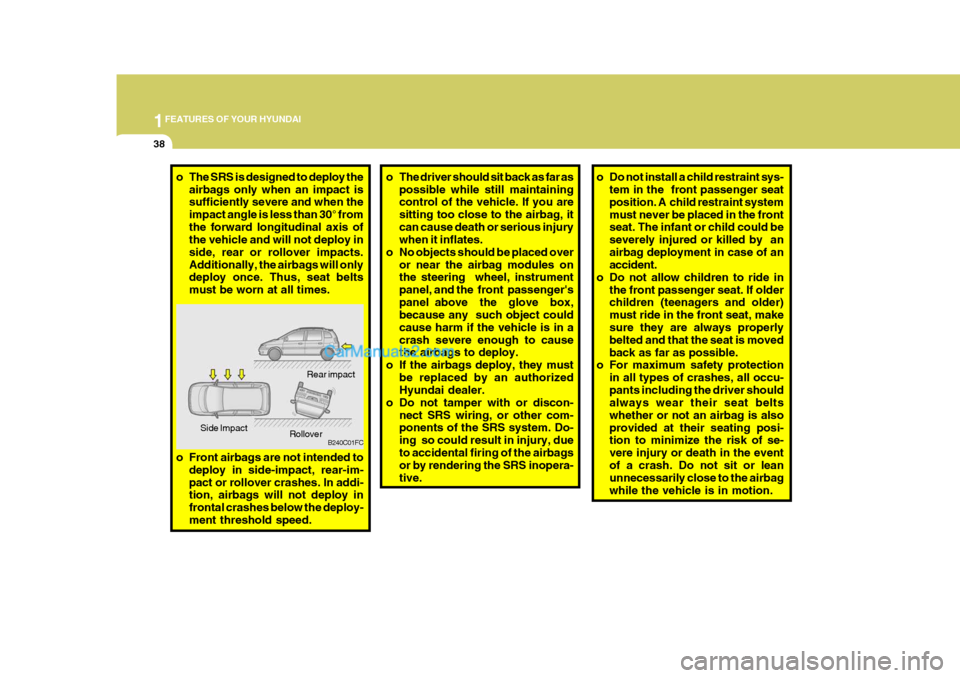
1FEATURES OF YOUR HYUNDAI
38
o Front airbags are not intended to
deploy in side-impact, rear-im- pact or rollover crashes. In addi- tion, airbags will not deploy in frontal crashes below the deploy-ment threshold speed.
o Do not install a child restraint sys-tem in the front passenger seat position. A child restraint systemmust never be placed in the front seat. The infant or child could be severely injured or killed by anairbag deployment in case of an accident.
o Do not allow children to ride in
the front passenger seat. If olderchildren (teenagers and older) must ride in the front seat, makesure they are always properly belted and that the seat is moved back as far as possible.
o For maximum safety protection
in all types of crashes, all occu-pants including the driver should always wear their seat belts whether or not an airbag is alsoprovided at their seating posi- tion to minimize the risk of se- vere injury or death in the eventof a crash. Do not sit or lean unnecessarily close to the airbag while the vehicle is in motion.o The driver should sit back as far as
possible while still maintaining control of the vehicle. If you are sitting too close to the airbag, itcan cause death or serious injury when it inflates.
o No objects should be placed over or near the airbag modules onthe steering wheel, instrument panel, and the front passenger'spanel above the glove box, because any such object could cause harm if the vehicle is in acrash severe enough to cause the airbags to deploy.
o If the airbags deploy, they must be replaced by an authorizedHyundai dealer.
o Do not tamper with or discon- nect SRS wiring, or other com-ponents of the SRS system. Do- ing so could result in injury, dueto accidental firing of the airbags or by rendering the SRS inopera- tive.
o The SRS is designed to deploy the
airbags only when an impact is sufficiently severe and when the impact angle is less than 30° fromthe forward longitudinal axis of the vehicle and will not deploy in side, rear or rollover impacts.Additionally, the airbags will only deploy once. Thus, seat belts must be worn at all times.
B240C01FC
Rear impact
Side Impact Rollover